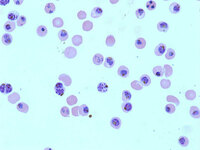To the Class of 2020: A note from Department Chair, Crislyn D’Souza-Schorey

Dear Biological Sciences and Environmental Sciences Graduates, heartiest congratulations to each of you. The annual Biological Sciences commencement celebration over commencement weekend is a hallowed and cherished tradition in our department and a well-deserved tribute to our seniors...
Growing Beauty: Tree survey marks 175 years of natural beauty at Notre Dame
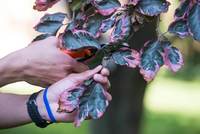
After trekking through the biting South Bend cold on Nov. 26, 1842, Rev. Edward Sorin, C.S.C., first laid eyes on the 524 acres bequeathed to the Congregation of Holy Cross to build a Catholic university, admired its two lakes and surrounding forest, and started planning his ideal landscape. He may have encountered a young sycamore tree that grows behind what is now Corby Hall. Currently one of the largest trees the University of Notre Dame’s campus, it is 80 feet tall and has thick, finger-like limbs that curl toward heaven in apparent angst. And certainly Father Sorin appreciated the ash trees, oaks, hickories and maples that surrounded St. Mary’s and St. Joseph’s lakes. But taming this “savage wilderness,” as one newspaper account in 1844 described the property, was necessary in order to create the pedestrian-friendly, academic utopia Father Sorin envisioned.
Little Giants: A closer look at a tiny bug with a big role to play

Michael Pfrender sits facing a whiteboard in his lab at the Galvin Life Science Center. He’s discussing the genomics of Daphnia – water fleas, found in every standing body of water in the world – and has a tendency to sketch when he speaks. “You want to see some of them?” he asks. “That’s the fun part, right?” At the back of the lab, two beakers sit on a table near a microscope. There isn’t much to see at first glance. Even leaning in, Daphnia are so small they look like bouncing flecks in the water, frantically trying to keep afloat.
In Memoriam: Professor Emeritus Harald E. Esch
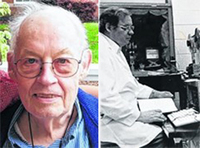
Dr. Harald E. Esch, Professor Emeritus of Biological Sciences, passed away peacefully on October 7, 2017, at the age of 85 in Farragut, TN. Dr. Esch was born in 1931 in Dusseldorf, Germany. Originally trained as a physicist and mathematician at the University of Bonn and Free University, Harald shifted to biology for his doctoral studies. At the University of Würzburg, Harald studied with Dr. Karl von Frisch, the 1973 Nobel Prize Laureate in Physiology or Medicine best known for his pioneering work on the ‘waggle dance’ of the common honeybee, Apis mellifera. Under von Frisch’s tutelage, Harald earned a doctorate in 1960 in Zoology and Mathematics for his work on insect chemosensory physiology. Harald remained in Germany until 1964 as an Assistant Professor in the Radiation Research Laboratory at the University of Munich Medical School, where he worked on the effects of ionizing radiation on cell membranes.
Fighting Mosquito-borne Diseases

“In general, cases of Zika have definitely decreased in most of Central and South America, but the virus is not gone. The mosquitoes carrying Zika and other diseases are still there, and the risk for another infection outbreak is still quite prevalent,” says Elitza Theel, director of the Infectious Diseases Serology Laboratory and co-director of the Vector-Borne Diseases Service Line at Mayo Clinic. Though Zika virus was identified in 1947, the World Health Organization (WHO) says it was largely localized for 60 years. In 2007, the first recognized outbreak of Zika affected 5,000 people on Yap Island in the Federated States of Micronesia. From there, it moved to French Polynesia and then in 2015 to Brazil, where an outbreak quickly devastated South America.
In memoriam: Robert McIntosh, professor emeritus of biological sciences
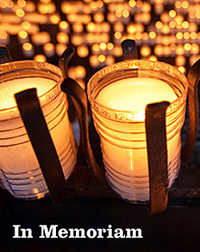
Robert P. McIntosh, a renowned ecologist and historian of ecology and wonderful husband, father and grandfather, died at 3:45 pm July 7, 2017. He was born Sept. 24, 1920, in Milwaukee, Wis., and was a football…
Xin Lu wins 2017 Indiana CTSI Young Investigator Award

Dr. Xin Lu, the John M. and Mary Jo Boler Assistant Professor of Biological Sciences, in the Boler-Parseghian Center for Rare and Neglected Diseases, has been awarded a Young Investigator Award from the Indiana Clinical and Translational Sciences Institute (CTSI).
Notre Dame scientists study the past to predict climate change
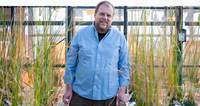
A chance meeting a decade ago in a graduate school hallway led paleoecologist Jason McLachlan to create a Jurassic Park-like wonder in Notre Dame’s greenhouse, where rows of salt marsh bulrushes have germinated from 100-year-old seeds.
Twenty-four graduate students win NSF GRFP awards
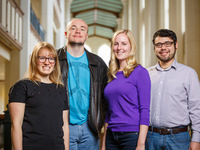
The National Science Foundation recently announced the winners of the 2016 Graduate Research Fellowship Program (GRFP), with 24 current Notre Dame students winning the prestigious award and another 17 earning honorable mention. Overall, there were 41 students recognized by the NSF. This doubles the number of Notre Dame awardees from 2015, and nearly doubles the previous Notre Dame record of 26, set last year, for total students recognized by the NSF. The NSF-GRFP recognizes and supports outstanding graduate students in NSF-supported science, technology, engineering, mathematics, and social science disciplines who are pursuing research-based degrees. The award provides a stipend, tuition support, and research funds for three years.
NDIIF announces awards for best imaging publications
The Notre Dame Integrated Imaging Facility (NDIIF) is pleased to announce two awards for best imaging publications for calendar year 2013. The 2013 Best Biological Imaging Publication was awarded to Giles E. Duffield, associate professor of biological sciences. Duffield and his coworkers have pioneered the use of Positron Emission Tomography (PET) to monitor the daily rhythms of small living animals. The 2013 Best Electron Microscopy Imaging Publication 2013 was awarded to Khachatur V. Manukyan, Ph.D., a post-doctoral research associate in the Department of Chemical and Biomolecular Engineering.
